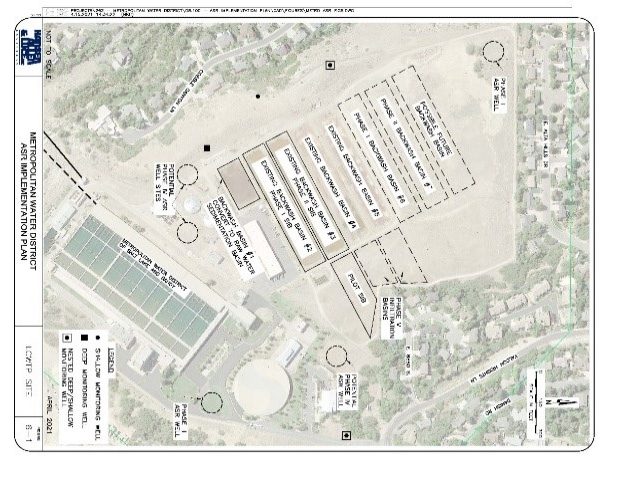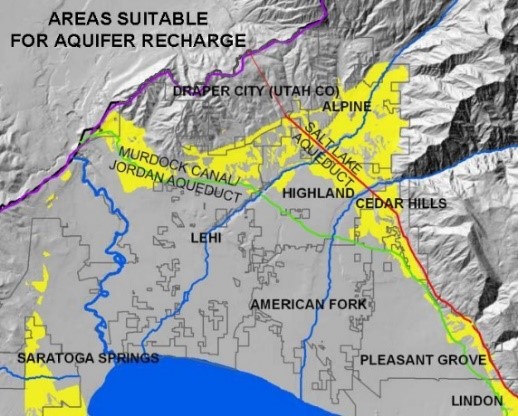July 11, 2022
Hansen, Allen & Luce (HAL) has led the engineering of two major Managed Aquifer Recharge (MAR) projects that will provide stable, long-term water storage opportunities for communities in Salt Lake and Utah Counties.
In wet years, excess runoff and/or excess water supply can be safely stored underground without risk of contamination or evaporation. In dry years, the water can be extracted, augmenting precious surface water sources.
More than a decade in the making, each project is now coming to fruition.
Metropolitan Water District of Salt Lake and Sandy

In 2021 HAL completed an Aquifer Storage and Recovery Implementation Plan for the Metropolitan Water District of Salt Lake and Sandy (MWDSLS) to capture and store early spring snowmelt runoff in the principal groundwater aquifer. The plan reviewed a 2009 study that proposed recharge through vadose zone wells at the MWDSLS Little Cottonwood Water Treatment Plant (LCWTP). Recent national experience, however, has shown that this technology is generally not recommended due to capital costs, the relatively short lifespan of vadose zone wells, and the availability of sufficient land for the construction of replacement wells.
As part of the 2021 study, HAL investigated multiple potential Surface Infiltration Basin (SIB) and Aquifer Storage and Recovery (ASR) well sites using critical factors such as land size, location, land ownership, recharge potential, proximity to existing pipe networks, power availability, and overall cost. The updated plan recommended a series of SIBs and ASR wells near Little Cottonwood Canyon. The sites include the LCWTP site, Quail Hollow Park, Sandy City property, and Dimple Dell Park. Each location was found suitable for both SIBs and ASR wells.
In February 2022 MWDSLS awarded HAL a follow-up project to design and assist with construction of Phase I of the implementation plan. HAL is refining the layout and design of two SIBs and one ASR well on the LCWTP site. Combined, the SIBs will cover approximately 4.3 acres, which at an infiltration rate of 5 ft/day would have the potential of recharging 21.5 ac-ft/day. The ASR well is projected to recharge 1,500 gpm which would add another 6.6 ac-ft/day. Construction of the SIBs and ASR well is scheduled for late 2022 or early 2023, followed by pilot testing which is projected to be completed by mid-2023 with full implementation by the end of 2024.
North Utah County Aquifer Council

The North Utah County Aquifer Council (NUCAC, formerly the North Utah County Aquifer Association) was organized by cities in north Utah County to manage the groundwater aquifer. All NUCAC cities depend heavily on groundwater as a source of drinking water. High growth rates in the area have resulted in declining groundwater levels. The Central Utah Water Conservancy District provided a grant to perform a feasibility study for an ASR project.
In 2012, HAL completed the initial ASR Feasibility Study. HAL used GIS to evaluate soil types, aquifer conductivity, and primary recharge area boundaries and identified locations where artificial recharge is most likely to be successful. A total of 16 alternative sites were evaluated and prioritized. Water sources were also evaluated; 13,000 ac-ft/yr was identified as being available from local streams. The top five sites were selected for implementation. These sites could provide an average recharge of 8,600 ac-ft/yr.
HAL is now assisting NUCAC with its ongoing groundwater monitoring program. This includes a more detailed evaluation of the Highland Gravel Pit (one of the prioritized recharge sites) through field investigations of infiltration rates and refinement of water availability estimates for recharge.
In May 2022 HAL was awarded a project to refine the conclusions of the 2012 study, including reviewing potential new locations, estimating project costs, and modeling the local aquifer systems to define aquifer response and recovery potentials. The study will also evaluate options for conjunctive use which has the potential to maximize surface and groundwater resources. The project is expected to be completed in 2023.